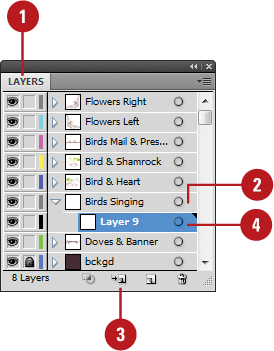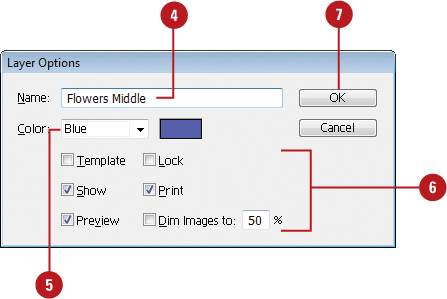Layers give you control over the design elements of
your document, so Illustrator makes sure you have plenty of layers
available to you. This flexibility guarantees that you have the creative
options to carry your designs to any level you desire. To create a new
layer, you must first have an open document. A new document in
Illustrator has a single top level layer. If you have more than one
document open, make sure the active image is the one to which you want
to add a layer. You can quickly create a top level layer or sublayer
using a button or add a layer and select options using a dialog box.
When you create a new vector object, you also create a sublayer with the
name <Path>. Each object that you create or place appears as a
new sublayer in the Layers panel.
Create a New Top Level Layer
 Select the Layers panel. Select the Layers panel.
 Click the top level layer that you want the new layer to appear above. Click the top level layer that you want the new layer to appear above.
 Click the New Layer button on the Layers panel. Click the New Layer button on the Layers panel.
A new top level layer appears with the name Layer and the next number in order.
 To rename the layer, double-click the layer, enter a name, and then click OK. To rename the layer, double-click the layer, enter a name, and then click OK.

Create a Sublayer
 Select the Layers panel. Select the Layers panel.
 Click the top level layer or sublayer that you want the new sublayer to appear within. Click the top level layer or sublayer that you want the new sublayer to appear within.
 Click the New Sublayer button on the Layers panel. Click the New Sublayer button on the Layers panel.
A new sublayer appears with the name Layer and the next number in order.
 To rename the layer, double-click the layer, enter a name, and then click OK. To rename the layer, double-click the layer, enter a name, and then click OK.

Create a New Top Level Layer or Sublayer with Options
 Select the Layers panel. Select the Layers panel.
 Click the top level layer that you want the new layer to appear above,
or sublayer that you want the new sublayer to appear within.
Click the top level layer that you want the new layer to appear above,
or sublayer that you want the new sublayer to appear within.
 Alt+click (Win) or Option+click (Mac) the New Layer or New Sublayer button on the Layers panel. Alt+click (Win) or Option+click (Mac) the New Layer or New Sublayer button on the Layers panel.
The Layer Options dialog box appears.

 Enter a name for the layer or sublayer. Enter a name for the layer or sublayer.
 Click the Color list arrow, and then select a color. Click the Color list arrow, and then select a color.
 Select the check boxes that you want to apply to the layer or sublayer: Select the check boxes that you want to apply to the layer or sublayer:
- Template. Select to make a template layer uneditable.
- Show. Select to show the layer in the Layers panel.
- Preview. Select to view the layer in Preview view.
- Lock. Select to lock the layer.
- Print. Select to enable printing for the layer. Nonprintable layers appear in italics in the Layers panel.
- Dim Images to 50%. Select to gray out images by the specified percentage.
 Click OK. Click OK.


|